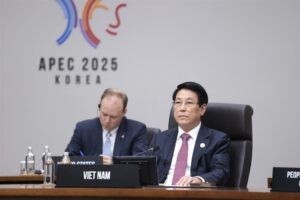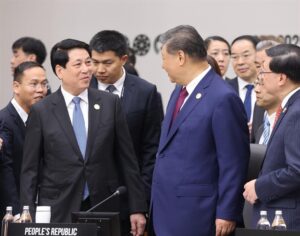Vietnam Faces 46% Tariff Under New US Trade Policy

Hanoi, The Gulf Observer: United States President Donald Trump has announced a new base tariff rate of 10 per cent on all imports into the country, with significantly higher rates imposed on nations with substantial trade surpluses. Under the policy, Vietnam will be subject to a 46 per cent tariff, the second-highest after Cambodia, which faces a 49 per cent levy.
Other affected economies include China (34 per cent), the European Union (20 per cent), India (26 per cent), and Japan (24 per cent). In Southeast Asia, Thailand will be subject to a 36 per cent tariff, followed by Indonesia (32 per cent), Malaysia (24 per cent), the Philippines (17 per cent), and Singapore (10 per cent).
Vietnam is one of the US’s key trade partners, with exports to the American market reaching approximately US$124 billion in 2023. The proposed tariff is expected to significantly impact major industries, including textiles, footwear, furniture, electronic components, and seafood.
The US remains the largest market for Vietnamese textiles, accounting for nearly 50 per cent of the industry’s total export revenue. Leading companies such as Vinatex, May 10, and TNG could experience financial strain as higher costs reduce orders and weaken purchasing power among US partners.
The technology sector is also expected to be affected. Apple, the world’s largest technology company, has shifted part of its production from China to Vietnam to avoid previous US tariffs. However, with the new 46 per cent levy, suppliers such as Foxconn, Luxshare, and Pegatron will encounter significantly higher costs.
“If this tariff is implemented, Apple and other technology firms will need to reassess their manufacturing strategies. Moving production from China to Việt Nam to avoid tariffs may no longer be a viable solution,” said Dan Ives, an analyst at Wedbush Securities.
This development could lead multinational companies to explore alternative manufacturing locations such as India or Mexico, potentially reducing Việt Nam’s attractiveness as a destination for foreign direct investment (FDI).
According to a White House statement, the general 10 per cent tariff will take effect on April 5, while higher tariffs on specific countries will be enforced starting April 9. This leaves Vietnamese exporters with less than a week to prepare for the economic impact.
Experts have suggested that Vietnam should intensify diplomatic efforts to negotiate exemptions or reductions for strategic products. Additionally, accelerating market diversification by expanding exports to Europe, Japan, South Korea, and the Middle East could help mitigate the adverse effects.
Encouraging US firms to invest directly in Vietnam’s manufacturing sector is also seen as a crucial strategy. Furthermore, providing domestic businesses with financial and tax policy support will be essential to help them adapt to the new trade conditions.
Vietnam’s export sector now faces a challenging period, requiring swift and strategic adjustments to maintain competitiveness and sustain economic growth.


